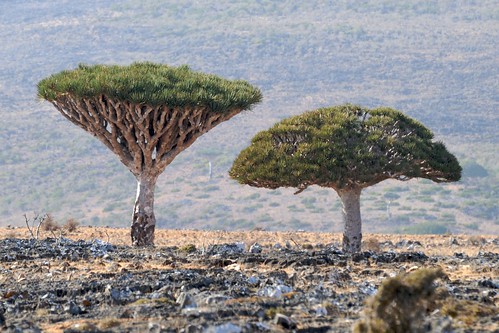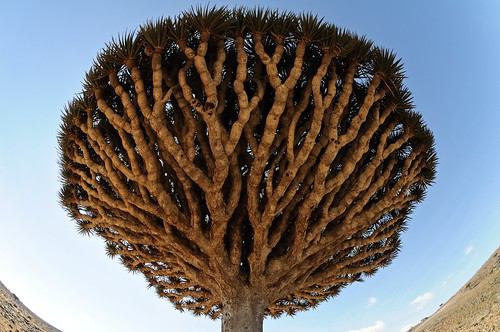
Dragon Tree – Root and Branch Review

A very distinctive and primitive tree. Legend has it that the tree sprang up from the spot where a dragon and elephant spilled blood and battled to death.
Key Features of the Dragon Tree
- Latin name – Dracaena Cinnabari – other common names inside-out umbrella tree’ or Dragon Blood Tree
- Height – up to 50 feet
- Type of tree – evergreen
- Leaves – Broad based spiky leaves in clusters at the top of vertical branches
- Flowers – pale yellow clusters
- Fruit – Yellow berry ripening to black
- Bark – Rough textured silvery grey
- Family – Dracaena
Origins and Distribution of the Dragon Tree
- Unique to the Indian Ocean island of Soqotra .
- The island is home to over 200 other plant species that are unique to the island.
Uses and Attributes of the Dragon Tree
- Cinnabar is a crimson red resin produced from the bark and leaves.
- Cinnabar was used as a pigment and to treat burns.
- The red dye is still used as a local lipstick and to treat stomach problems.
Gardeners Tips for the Dragon Tree
- Dragon trees grow in arid semi-desert areas.
- House plants of Dracaena are shrubby species only vaguely related to the Dragon Tree.
Other types of Dragon Trees
- Dracaena americana, Dracaena arborea, Dracaena draco, Dracaena ombet, and Dracaena tamaranae are all commonly known as dragon trees.
- Those species are tree-sized with stout trunks and stiff, broad-based leaves. The remaining Dracaena species are known collectively as shrubby dracaenas.
and grow in arid semi-desert areas.
Dragon Tree comments from elsewhere
Conservation The dragon’s blood tree is given some protection from international commercial trade under the listing of all Dracaena species on Appendix II of CITES (3), but if its populations are to be effectively preserved, a variety of measures will need to be taken. These include urgent monitoring of the species’ natural regeneration and the expansion of Skund Nature Sanctuary to cover important areas of the habitats. Also, efforts on avoiding road construction in the dragon blood’s habitat, and limit grazing need to be brought to attention. Additional conservation efforts for the tree involve fencing against livestock, watering of seedlings in open areas, and involving local communities in planting seedlings’ wikipedia extract.
Credits
“Dragon’s Blood trees both by Stefan Geens CC BY-NC-SA 2.0
“Haghier massif and Diskum plateau by Stefan Geens CC BY-NC-SA 2.0

